Article (Archive)
BANKS PENINSULA, New Zealand—Armed with a .22-caliber rifle, a GPS tracker and a dog named Scmack, Jason Millichamp set off into the hills here with a license to kill. His mission: find and eliminate brushtail possums, an intruder that eats baby birds and strips vegetation from native trees.
Millichamp, a 59-year-old former helicopter mechanic, is on the front lines of New Zealand’s drive to be “predator free” by 2050. That means eradicating invasive species such as possums, rats and mustelids—a group that includes weasels, ferrets and stoats.
Millichamp and Scmack, who can locate possums with his nose, are the mop-up team. They are often deployed to find the last few animals, after most possums in an area have been killed with poison and traps.
It’s not an easy job. On their recent expedition at a cattle farm overlooking a picturesque bay, Scmack detected a possum living in a hollow tree on a hillside. By the time Millichamp scrambled up, he couldn’t find it.
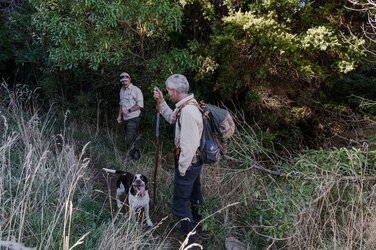
Ollie Rutland-Sims, left, Jason Millichamp and their canine partner Scmack strive to eliminate possums not already killed by poison and traps.
But farther down the trail, Scmack found another possum deep in a cluster of vines. Millichamp poked toward the animal with his walking stick, and then shot it. Scmack retrieved the animal, but it was still alive, so Millichamp had to shoot the possum again.
“Unfortunately, to protect our birds, we’ve got to kill these things,” Millichamp said. “In essence, it shouldn’t be here.”
Countries all over the globe are fighting against invasive species as the world becomes more interconnected. In the U.S., foreign mussels are wreaking havoc in the Great Lakes, invasive fungi are threatening trees in Hawaii and non-native carp are invading rivers and lakes. Many governments employ strict biosecurity rules at points of entry, such as throwing away fresh fruit and meat and inspecting imported wildlife.
New Zealand’s campaign is unusual because it aims to eradicate small, mobile and fast-breeding predators from the entire nation. Increasingly sophisticated traps, equipped with cameras and artificial intelligence that can identify species in real time, are being deployed. Scientists have developed a toxic bait that specifically targets rats and is largely harmless to other animals. Researchers are exploring whether genetic technology can stop some creatures from breeding.
But the effort, introduced nearly a decade ago, is proving controversial. Animal-rights groups are alarmed about the ethics of killing millions of creatures. Some scientists argue that alternative approaches, such as moving threatened animals to sanctuaries with predator-proof fences, might make more sense.
The predator-free plan “retains the dream of permanently eliminating highly fertile and short-lived pests by direct frontal assault—lethal control—over large geographic areas,” said Carolyn King, an emeritus professor at the University of Waikato who has studied stoats. Although the plan is inspiring and has had some local successes, “it has never explained how it can do this at landscape scale,” she said.
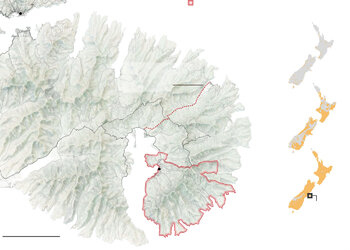
Sources: European Space Agency (imagery); Pest Free Banks Peninsula; Manaaki Whenua – Landcare Research (timeline) Carl Churchill
Some native animals are easy prey. Kiwi chicks are likely to be eaten by stoats without some form of predator control. A government report last year estimated that more than 75% of native reptile, bird, bat and freshwater fish species groups are threatened with extinction, or are at risk.
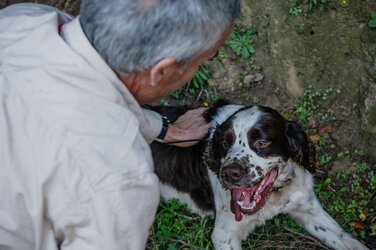
Scmack can locate possums with his nose.
“Either we accept that we’re on this journey of biodiversity decline, or we do something about it,” said James Willcocks, director of the citywide program to eliminate predators in Wellington, New Zealand’s capital.
Others worry that the goal is unachievable without a radical leap in technology. The target predators often breed faster than they can be removed, catching the last few animals that avoid traps or baits is time-consuming and costly, and guarding against reinvasion is difficult, scientists say.
Airdropped poison baits have been used to eradicate predators from uninhabited islands, but that is a problematic strategy if people live nearby. Another issue: The official plan doesn’t include feral cats, an invasive predator, or non-native animals such as deer and pigs that destroy habitats needed for local fauna to thrive.
An artsy display of taxidermy contrasts with New Zealand's deadly serious effort to eliminate predators.
Then there is the cost. The latest estimates suggest up to $6 billion will be needed for the campaign to succeed. That could be a challenge for a country of 5.3 million people—roughly the population of South Carolina—that has been struggling economically.
“Most people would love it if rats and possums and stoats would be removed from the country. If you could press a button, almost everyone would do it,” said Ally Palmer, a senior research fellow at the University of Auckland who has studied public perception of the program. “But there are some ongoing concerns about the ‘How?’ And also, about the ‘Can we?’”
On one predator-free island—home to threatened species such as a flightless parrot called the kakapo—the government spent some $295,000 over eight months tracking down a single stoat. Still, that was cheaper than moving the threatened animals and eradicating predators from an entirely new island, officials say. The effort involved trap experts, dogs, trail cameras, setting and monitoring 100 traps, and helicopters to transport people and equipment.
Even some supporters aren’t sure the 2050 nationwide goal is achievable. “I think it’s a pipe dream,” said 83-year-old Georgie Oborne, who lives on the Banks Peninsula, where Millichamp and Scmack track possums. “The money will run out.”
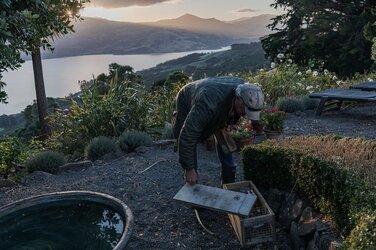
A pest trap on Banks Peninsula, a hilly, farming area on New Zealand’s South Island.
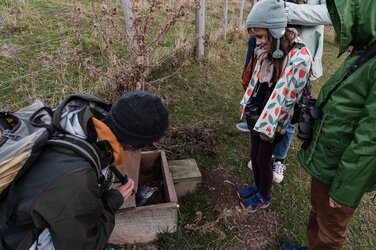
A tour guide on Banks Peninsula opens a nesting box with protected native penguins.
“If we get this right, we just do this once, and we’ve reset the country and native wildlife can thrive,” said Brent Beaven, the official at New Zealand’s conservation department in charge of the strategy.
In 18 key locations across the country—from rugged mountains to rolling farmlands to the suburbs—conservation groups are experimenting to determine what works best in different environments. One of these is the Banks Peninsula, a hilly, farming area on New Zealand’s South Island that is also popular with retirees and tourists. Visitors can take a tour of a penguin colony nearby.
Possums are the initial target for eradication here. Ollie Rutland-Sims, a 26-year-old operations coordinator for Pest Free Banks Peninsula, the group doing the elimination, estimates 120,000 possums lived in the 90 square miles in the project’s first phase. He figures in about 35 square miles, there are just a few individual possums left.
“We’ve been really blown away with how large the population is in a lot of places,” he said.
Their strategy is multifaceted. Initially, the conservationists install plastic containers with toxic bait in trees, with self-resetting kill traps often placed along borders to slow new animals from coming in. The possum-tracking dog will later do a sweep, and if needed, the team will deploy extra traps to take out survivors that didn’t go for the bait.
The conservationists then move into neighboring areas with the bait, leaving behind traps and cameras to protect against and monitor for reinvasion. They’ll send in the possum-tracking dog if invaders get through, though the traps can be a good defense. On a recent afternoon, more than 10 possum carcasses were piled up under one trap, set in a tree on the side of a road.

Some residents worry that the use of toxic bait could harm pets and the local environment. Photo: Tatsiana Chypsanava for The Wall Street Journal
“For me, it’s around the unintended consequences of those toxins,” Kinnaird said.
The conservation group says the risk to pets is low given how they deploy the poison, that they wouldn’t put toxins near water sources, and that toxins are the most efficient way to reduce possum numbers quickly. They say that they aim to kill animals in the most humane way possible and that it is up to landowners to decide which methods to permit on their property.
Supporters of the 2050 plan say there are already important achievements. About 450 square miles across the country are newly free from at least some of the target predators, according to Predator Free 2050, a government-owned company set up to implement the program. Bird counts are up in some areas where predator elimination work has occurred, it says.
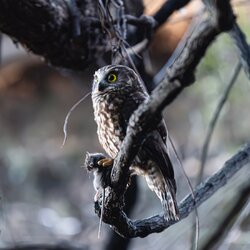
More than three-quarters of New Zealand's native reptile, bird, bat and freshwater fish species groups are threatened with extinction, or are at risk, the government says.
In Wellington, one of the 18 locations where conservation groups are experimenting, the citywide group used thousands of traps and bait stations, tracker dogs, hundreds of cameras, and reports from community members to eliminate rats and mustelids from the suburban Miramar peninsula (possums were already gone). Another project has reintroduced kiwis to the hills around Wellington after a trapping campaign reduced predator numbers.
The Wellington group is pushing into new neighborhoods toward the downtown, while maintaining a vigilant watch for invaders. Some weeks ago, a community member noticed a dead rat that a tracker dog later traced to firewood that had recently been delivered.
“We’re reasonably confident that we can do possums,” said Rob Forlong, chief executive of Predator Free 2050. “With rats and stoats, they are a lot harder.”
Toni Williams, 52, who lives on the Banks Peninsula, said he has seen a three- or fourfold increase in the number of tui, a native bird, at a feeder near his house.
At first, he was skeptical possums could be eliminated from the area. Now, he thinks there is a chance.
“I can see the results myself,” he said.
BANKS PENINSULA, New Zealand—Armed with a .22-caliber rifle, a GPS tracker and a dog named Scmack, Jason Millichamp set off into the hills here with a license to kill. His mission: find and eliminate brushtail possums, an intruder that eats baby birds and strips vegetation from native trees.
Millichamp, a 59-year-old former helicopter mechanic, is on the front lines of New Zealand’s drive to be “predator free” by 2050. That means eradicating invasive species such as possums, rats and mustelids—a group that includes weasels, ferrets and stoats.
Millichamp and Scmack, who can locate possums with his nose, are the mop-up team. They are often deployed to find the last few animals, after most possums in an area have been killed with poison and traps.
It’s not an easy job. On their recent expedition at a cattle farm overlooking a picturesque bay, Scmack detected a possum living in a hollow tree on a hillside. By the time Millichamp scrambled up, he couldn’t find it.

Ollie Rutland-Sims, left, Jason Millichamp and their canine partner Scmack strive to eliminate possums not already killed by poison and traps.
But farther down the trail, Scmack found another possum deep in a cluster of vines. Millichamp poked toward the animal with his walking stick, and then shot it. Scmack retrieved the animal, but it was still alive, so Millichamp had to shoot the possum again.
“Unfortunately, to protect our birds, we’ve got to kill these things,” Millichamp said. “In essence, it shouldn’t be here.”
Countries all over the globe are fighting against invasive species as the world becomes more interconnected. In the U.S., foreign mussels are wreaking havoc in the Great Lakes, invasive fungi are threatening trees in Hawaii and non-native carp are invading rivers and lakes. Many governments employ strict biosecurity rules at points of entry, such as throwing away fresh fruit and meat and inspecting imported wildlife.
New Zealand’s campaign is unusual because it aims to eradicate small, mobile and fast-breeding predators from the entire nation. Increasingly sophisticated traps, equipped with cameras and artificial intelligence that can identify species in real time, are being deployed. Scientists have developed a toxic bait that specifically targets rats and is largely harmless to other animals. Researchers are exploring whether genetic technology can stop some creatures from breeding.
But the effort, introduced nearly a decade ago, is proving controversial. Animal-rights groups are alarmed about the ethics of killing millions of creatures. Some scientists argue that alternative approaches, such as moving threatened animals to sanctuaries with predator-proof fences, might make more sense.
The predator-free plan “retains the dream of permanently eliminating highly fertile and short-lived pests by direct frontal assault—lethal control—over large geographic areas,” said Carolyn King, an emeritus professor at the University of Waikato who has studied stoats. Although the plan is inspiring and has had some local successes, “it has never explained how it can do this at landscape scale,” she said.

Sources: European Space Agency (imagery); Pest Free Banks Peninsula; Manaaki Whenua – Landcare Research (timeline) Carl Churchill
Up to $6 billion cost
For this volcanic country in the South Pacific, the plan tackles a legacy of its colonial past. New Zealand’s native animals, including flightless birds like the kiwi, evolved without ground-dwelling mammalian predators. That made them vulnerable to the mammals that arrived with European settlers in the 19th century.Some native animals are easy prey. Kiwi chicks are likely to be eaten by stoats without some form of predator control. A government report last year estimated that more than 75% of native reptile, bird, bat and freshwater fish species groups are threatened with extinction, or are at risk.

Scmack can locate possums with his nose.
“Either we accept that we’re on this journey of biodiversity decline, or we do something about it,” said James Willcocks, director of the citywide program to eliminate predators in Wellington, New Zealand’s capital.
Others worry that the goal is unachievable without a radical leap in technology. The target predators often breed faster than they can be removed, catching the last few animals that avoid traps or baits is time-consuming and costly, and guarding against reinvasion is difficult, scientists say.
Airdropped poison baits have been used to eradicate predators from uninhabited islands, but that is a problematic strategy if people live nearby. Another issue: The official plan doesn’t include feral cats, an invasive predator, or non-native animals such as deer and pigs that destroy habitats needed for local fauna to thrive.
An artsy display of taxidermy contrasts with New Zealand's deadly serious effort to eliminate predators.
Then there is the cost. The latest estimates suggest up to $6 billion will be needed for the campaign to succeed. That could be a challenge for a country of 5.3 million people—roughly the population of South Carolina—that has been struggling economically.
“Most people would love it if rats and possums and stoats would be removed from the country. If you could press a button, almost everyone would do it,” said Ally Palmer, a senior research fellow at the University of Auckland who has studied public perception of the program. “But there are some ongoing concerns about the ‘How?’ And also, about the ‘Can we?’”
On one predator-free island—home to threatened species such as a flightless parrot called the kakapo—the government spent some $295,000 over eight months tracking down a single stoat. Still, that was cheaper than moving the threatened animals and eradicating predators from an entirely new island, officials say. The effort involved trap experts, dogs, trail cameras, setting and monitoring 100 traps, and helicopters to transport people and equipment.
Even some supporters aren’t sure the 2050 nationwide goal is achievable. “I think it’s a pipe dream,” said 83-year-old Georgie Oborne, who lives on the Banks Peninsula, where Millichamp and Scmack track possums. “The money will run out.”

A pest trap on Banks Peninsula, a hilly, farming area on New Zealand’s South Island.

A tour guide on Banks Peninsula opens a nesting box with protected native penguins.
Technological leap needed
Conservation officials say the predator-free plan will become more feasible as new technology comes online, bringing down costs. They compare it to the moon landing—pointing out the U.S. didn’t have the technology to succeed when that goal was announced in the early 1960s.“If we get this right, we just do this once, and we’ve reset the country and native wildlife can thrive,” said Brent Beaven, the official at New Zealand’s conservation department in charge of the strategy.
In 18 key locations across the country—from rugged mountains to rolling farmlands to the suburbs—conservation groups are experimenting to determine what works best in different environments. One of these is the Banks Peninsula, a hilly, farming area on New Zealand’s South Island that is also popular with retirees and tourists. Visitors can take a tour of a penguin colony nearby.
Possums are the initial target for eradication here. Ollie Rutland-Sims, a 26-year-old operations coordinator for Pest Free Banks Peninsula, the group doing the elimination, estimates 120,000 possums lived in the 90 square miles in the project’s first phase. He figures in about 35 square miles, there are just a few individual possums left.
“We’ve been really blown away with how large the population is in a lot of places,” he said.
Their strategy is multifaceted. Initially, the conservationists install plastic containers with toxic bait in trees, with self-resetting kill traps often placed along borders to slow new animals from coming in. The possum-tracking dog will later do a sweep, and if needed, the team will deploy extra traps to take out survivors that didn’t go for the bait.
The conservationists then move into neighboring areas with the bait, leaving behind traps and cameras to protect against and monitor for reinvasion. They’ll send in the possum-tracking dog if invaders get through, though the traps can be a good defense. On a recent afternoon, more than 10 possum carcasses were piled up under one trap, set in a tree on the side of a road.

Some residents worry that the use of toxic bait could harm pets and the local environment. Photo: Tatsiana Chypsanava for The Wall Street Journal
Concerns about poisons
Many people are supportive of the project, though some locals are unsettled by the use of poison. David Kinnaird, 54, who runs a guest lodge on the Banks Peninsula, was happy to allow tracker dogs and certain traps that catch animals alive—but said no to toxic bait. He was worried about his pet cat, and contaminating local water sources.“For me, it’s around the unintended consequences of those toxins,” Kinnaird said.
The conservation group says the risk to pets is low given how they deploy the poison, that they wouldn’t put toxins near water sources, and that toxins are the most efficient way to reduce possum numbers quickly. They say that they aim to kill animals in the most humane way possible and that it is up to landowners to decide which methods to permit on their property.
Supporters of the 2050 plan say there are already important achievements. About 450 square miles across the country are newly free from at least some of the target predators, according to Predator Free 2050, a government-owned company set up to implement the program. Bird counts are up in some areas where predator elimination work has occurred, it says.

More than three-quarters of New Zealand's native reptile, bird, bat and freshwater fish species groups are threatened with extinction, or are at risk, the government says.
In Wellington, one of the 18 locations where conservation groups are experimenting, the citywide group used thousands of traps and bait stations, tracker dogs, hundreds of cameras, and reports from community members to eliminate rats and mustelids from the suburban Miramar peninsula (possums were already gone). Another project has reintroduced kiwis to the hills around Wellington after a trapping campaign reduced predator numbers.
The Wellington group is pushing into new neighborhoods toward the downtown, while maintaining a vigilant watch for invaders. Some weeks ago, a community member noticed a dead rat that a tracker dog later traced to firewood that had recently been delivered.
“We’re reasonably confident that we can do possums,” said Rob Forlong, chief executive of Predator Free 2050. “With rats and stoats, they are a lot harder.”
Toni Williams, 52, who lives on the Banks Peninsula, said he has seen a three- or fourfold increase in the number of tui, a native bird, at a feeder near his house.
At first, he was skeptical possums could be eliminated from the area. Now, he thinks there is a chance.
“I can see the results myself,” he said.

